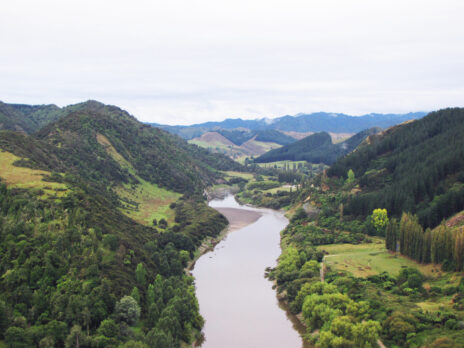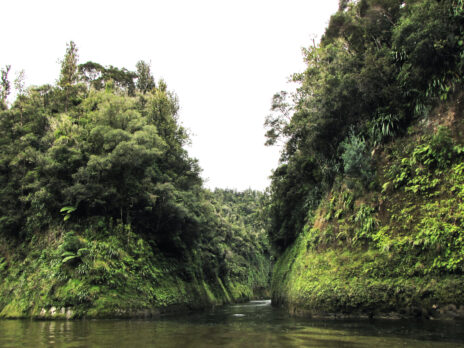 Whanganui river
Whanganui riverFoto: Anna Martin
February 2018 – after hours of driving through the mountainous landscape of New Zealand’s North Island, we catch the first glimpse of the Whanganui. The river flows from the volcanic Mount Tongariro to the Tasman Sea. With its 290 kilometers, it is the longest navigable river of the country. As students in Environmental Communication, we travelled to New Zealand in 2018 to conduct interviews for our Master’s Thesis Testing the (legal) waters: interpreting the political representation of a river with rights in New Zealand. Within this research, we asked ourselves: How is the Whanganui River planned to be politically represented as a legal person when implementing the legislation?
The story of how the Whanganui River gained legal rights goes back a long time in history. Māori, the indigenous peoples of New Zealand, see human and nature as interconnected and regard the River as their spiritual ancestor. In the 19th century – when New Zealand was a British colony – the Whanganui was degraded ecologically and the cultural ties were not recognized, causing many grievances. Following 140 years of struggle, negotiations between the local Māori tribe and the British Commonwealth finally resulted in a legislation that granted legal personhood to the River. The legislation is commonly viewed as a compromise – an arrangement in which neither government nor the Māori own the Whanganui, but in which the river legally acquires ownership itself. As a legal person, the river’s right to maintain its holistic health and wellbeing – to flourish ecologically and socially – is now recognized. This indigenous worldview forms the backbone of the legislative implementation and its moral starting point. The legal entity, called ‘Te Awa Tupua’, includes all of the River’s natural, human and spiritual components as an indivisible living whole, from the mountains to the sea.
Two people, jointly appointed by the Māori and the government, serve as the official human faces of the river and speak in its best interest. Furthermore, a strategy group was established, including different types of expertise, knowledge systems and worldviews of actors with a clear connection to the river such as Māori, local authorities, as well as representatives from the environmental and private sectors. Based on this arrangement, one may ask how this selected group of people can represent nature in all its complexity. Which knowledge and qualities does one need to possess when speaking on behalf of such an ecosystem, including its voiceless subparts such as the fish, water and plants?
The strategy group is currently developing a document to assess and determine the ‘health and wellbeing’ of the river, which will serve as a starting point to all decisions that relate to the river. This process includes ‘interweaving’ different kinds of knowledge and ways of assessing what the river needs to flourish. Nevertheless, some of the actors involved in setting up or carrying out the legislation recognize a challenge in combining both scientific ways of segmenting the river (in order to monitor water quality or manage fish populations) as well as adapting to a more holistic way to look at the river and learning from indigenous narratives and traditions. In effect, this also means that economic developments, such as a planned 6 million dollar investment in the river’s port, have to be benchmarked against the intrinsic rights of the river as a whole. On that note, how can one justify taking for example the river’s water for hydroelectric power, when anthropomorphic claims are made that this arguably damaging act can be compared to taking blood from a person? Besides, to some, the responsibilities connected to the term ‘legal person’ has its challenges (as people now might think it can be sued once it overflows), whereas others recognize the strength of the river’s new status as it humanizes the ecosystem and possibly galvanizes more support for its conservation.
 The broader ecocentric idea of seeing human as part of nature, rather than dominating and separated from it, is also expected to be promoted by funding made available by the new legislation. For example, the idea of an audio installation has been raised through which the ‘voice of the river’ can be heard and visitors to the surrounding national park will be informed about the river’s personhood, wellbeing and history.
The broader ecocentric idea of seeing human as part of nature, rather than dominating and separated from it, is also expected to be promoted by funding made available by the new legislation. For example, the idea of an audio installation has been raised through which the ‘voice of the river’ can be heard and visitors to the surrounding national park will be informed about the river’s personhood, wellbeing and history.Foto: Anna Martin
A pragmatic way of making such balanced decisions lies in recognizing a reciprocal relation with the river, or hau in Māori. When you take something from nature, you are expected to give something back. This cultural norm is supported by a personal and local connection to the river by ‘living with it’. We found this deep connection – a vital criterion in the selection process of appointing the official representatives – enabling the people living close to the river to speak on behalf of it, wherein the law is expected to function as a tool to legitimize this way of relating to nature.
All in all, what can we learn from the implementation of this New Zealand case? Obviously, this particular river community has had its problematic (post)colonial history, however with the river’s new legal status, previously conflicting perspectives are brought together and an attitude based on listening to the community as well as to the river is adopted. Secondly, by taking the Whanganui as an example, other communities could too take these initiatives in their own hands, facilitate pluralist dialogue to make sure both human and non-human voices are heard. All in the hope of causing a paradigm shift where humanity is seen as part of nature. Or, as portrayed in this local Māori proverb, “Ko au te Awa, ko te Awa ko au – I am the river, the river is me”.
This article is based on the Master’s thesis in Environmental Communication and Management (SLU) called “Testing the (legal) waters – Interpreting the political representation of a river with rights in New Zealand”. Read the full thesis here, which is currently under review to become a journal article
